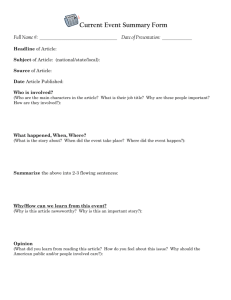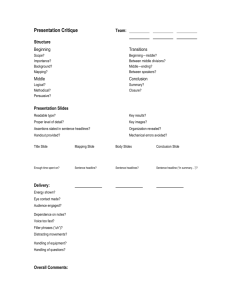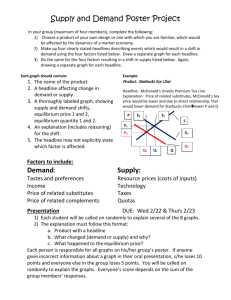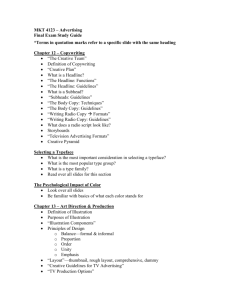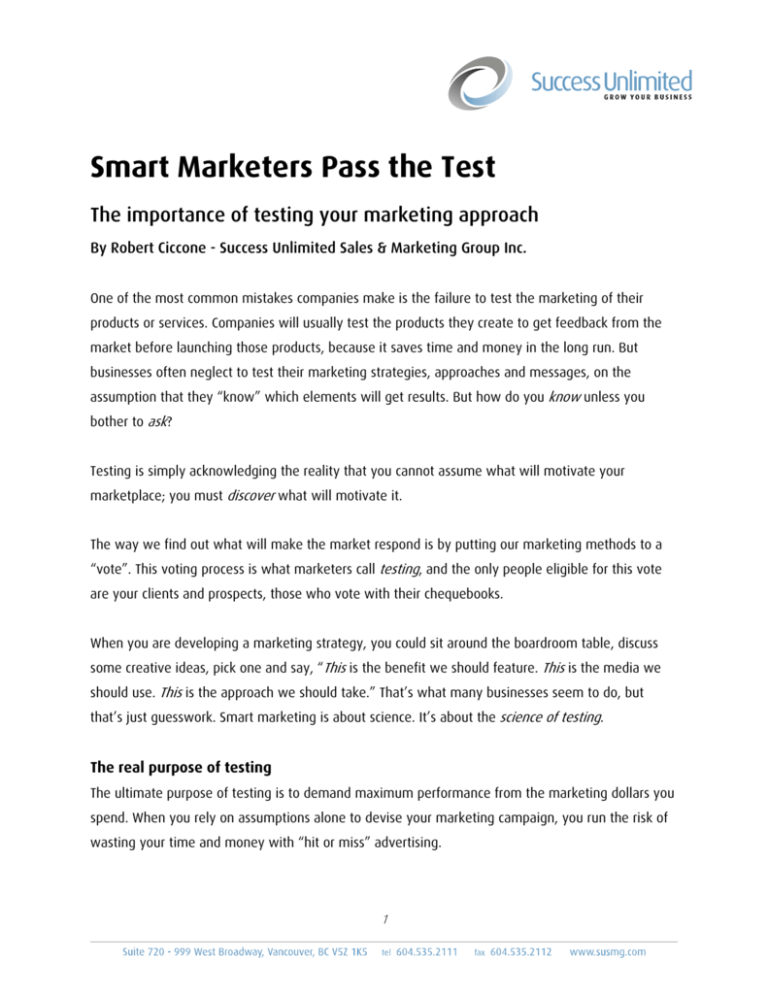
Smart Marketers Pass the Test
The importance of testing your marketing approach
By Robert Ciccone - Success Unlimited Sales & Marketing Group Inc.
One of the most common mistakes companies make is the failure to test the marketing of their
products or services. Companies will usually test the products they create to get feedback from the
market before launching those products, because it saves time and money in the long run. But
businesses often neglect to test their marketing strategies, approaches and messages, on the
assumption that they “know” which elements will get results. But how do you know unless you
bother to ask?
Testing is simply acknowledging the reality that you cannot assume what will motivate your
marketplace; you must discover what will motivate it.
The way we find out what will make the market respond is by putting our marketing methods to a
“vote”. This voting process is what marketers call testing, and the only people eligible for this vote
are your clients and prospects, those who vote with their chequebooks.
When you are developing a marketing strategy, you could sit around the boardroom table, discuss
some creative ideas, pick one and say, “This is the benefit we should feature. This is the media we
should use. This is the approach we should take.” That’s what many businesses seem to do, but
that’s just guesswork. Smart marketing is about science. It’s about the science of testing.
The real purpose of testing
The ultimate purpose of testing is to demand maximum performance from the marketing dollars you
spend. When you rely on assumptions alone to devise your marketing campaign, you run the risk of
wasting your time and money with “hit or miss” advertising.
1
With testing, you can find out definitively that one approach or element will substantially outperform another. Let’s say you want to send out a marketing letter to 2,000 prospective customers.
It will cost you the same amount of money to produce, print and mail that letter to those 2,000
people, whether that letter results in two new customers or 20; so don’t settle for just the two. If
you take the time to test the letter before you send it out to all 2,000 prospects, you will get more
bang for the buck because you will know which approach will work best, and you will know it’s the
winning combination of elements you are using in your marketing letter. If you’re going to send that
letter anyway, don’t you want to make sure you send the one that will get the best results?
Three benefits of testing
Testing helps your business save money, because you can start small before you invest the big bucks
on the full campaign. Instead of sending a mailing to your entire list of 10,000, you could select a
sampling of 500 where you create two versions of your mailing, send those out, and see which gets
the better response. Then use the winner to mail out to your full list.
Testing helps you improve upon the results you’re already getting. In fact, it puts you on the fast
track to constant improvement. If I am getting a certain result from my existing ad, sales script or
activity, I can tweak it and test the existing one against the new version, which will allow me to
improve my results.
Testing allows you to stop guessing about what works, and focus on the facts. It turns your
marketing efforts into a science instead of making decisions based on subjective information. It
allows you to be more objective about your marketing. John Capels, in his book Tested Advertising
Methods, makes the point that testing allows you to “guard against an advertising manager or copy
chief whose pet ideas may be hurting your advertising; an ad agency whose idea of agency service
is merely to turn out pretty layouts and stereotyped copy; and mistaken ideas that you yourself may
have had in regard to your advertising. Testing enables you to throw opinion overboard and get
down to facts.”
2
I recently wrote a quarter-page ad for a client, but the client wanted to change the bonus offer to
something they felt would have more appeal and get a better result. But when I was able to produce
the testing results for both offers, the results showed that the original bonus offer outperformed the
company’s alternative… and the client went with my original suggestion. It’s not about who was
right and who was wrong, but that the test results gave the client the confidence to make the best
choice for that campaign, without giving in to subjective opinion.
What to test
So now that we’ve established why we want to test, let’s look at what to test. Testing applies to
everything you do in terms of your marketing. If you’re doing mailings or have a web site, for
example, you could test one headline or lead-off versus another; one body copy vs. another; one
bonus vs. another; or one guarantee vs. another.
If you run a radio ad, test one call to action vs. another. If you run a print ad, test one page position
vs. another. If you’re a sales person, test your opening 11 words vs. another opening line.
Test your packages. Test your upgrade offers. Test your follow-up offers. Test your web site
navigation. Test your sales scripts. Test how you respond to a customer’s objections. And yes, you
should even test your prices.
Testing prices, by the way, does not necessarily mean going lower and lower. Fifty percent of the
time, when I test prices, I find that a higher price will actually get better results than the lower price.
People often under-price out of fear or intimidation, thinking no one will buy at the higher price. In
Robert Cialdini’s book, Influence: The Power of Persuasion, the author tells a story about a jeweler
who had a line of jewelry that wasn’t selling. He decided to cut prices on that line, just to get rid of
it. Then he went on vacation and left instructions with his sales rep that he should cut prices on that
line by 50%. But the sales rep made a mistake and misunderstood the instructions, and ended up
raising the prices by 50%. When the jeweler returned from vacation, he was astonished to find that
every piece of that line of jewelry had sold, at the marked up price!
3
Why did the jeweler think he had to drop his prices in order to sell that merchandise? He made that
decision out of fear, and he assumed – he didn’t test. The lesson? Test everything, even your prices.
The “Golden Rule” of testing
Test one, and only one, element at a time. This is the golden rule of testing any marketing approach.
Just as a scientist in a lab will change only one element at a time during his experiments, and will
test against standard “control” elements, you must do the same when testing your marketing
approach. If you change more than one element at a time, how will you know which is working and
which is not?
If you are changing the headline to test it, then keep the body copy, price, or other elements the
same in both your “control” and “test” versions. Don’t change both the headline and the price; or the
headline and the discount offer.
Examples of the impact of testing
Ben Franklin said, “The definition of insanity is doing the same thing over and over, and expecting
different results.” When you test by changing one thing, even a small thing, you will get different
results; you can then measure those results and make an informed and scientific decision about
which way you want to go next.
Let’s look at some examples to demonstrate how simply changing one element, such as a headline,
can have a dramatic bottom-line result, a result that you would never discover unless you tested it.
Example #1
Headline A: “Moisturized shave cream.”
Headline B: “Push-button shave cream.”
Result: Which one do you think did better? A outperformed B by 82%.
4
Example #2
Headline A: “If you are a careful driver, you can save money on car insurance.”
Headline B: “How to turn your careful driving into money.”
Result: Headline A outperformed B by 50%.
Example #3
Headline A: “Good news for men who want attractive, well-groomed hair.”
Headline B: “Will your scalp stand the fingernail test?”
Result: Headline B brought in 56% more responses than A.
Example #4
Headline A: “Tension headache?”
Headline B: “When doctors have headaches, what do they do?”
Result: Headline B drew in 71% more responses.
Example #5
Headline A: “How to keep your hair-do prettier, longer.”
Headline B: “Tired of sticky hairsprays?”
Result: Headline B pulled a full 79% more responses than A.
These examples and their significant results came from actual marketing tests performed on these
headlines. Now, could you have picked the winners from each group before you knew what the test
results showed? If not, you’ll know why making assumptions in marketing is so dangerous. Think
about it: what would a 79 or 82% difference mean if it were your business? The catchiest, most
clever headline or ad slogan isn’t always guaranteed to get you the best results… but would you
know that if you didn’t bother to test?
Whether you create your own marketing program or hire someone else to do it, if you’re not testing
it, how do you know if it’s getting the best results? By understanding and using testing as part of
your marketing strategy, you become a precise marketer. Instead of playing an endless guessing
5
game, you begin to treat marketing as a science that must be watched carefully and continuously
tested with different variables so that you can constantly improve your results again and again over
time.
Marketing isn’t guessing. Put on your lab coat, and be scientific about your marketing.
Copyright ©2007 Robert Ciccone. All rights reserved. For reprint permission, contact info@susmg.com
________________________________________________________________________________
About the Author
Robert Ciccone is the president and founder of Success Unlimited Sales and Marketing Group
www.susmg.com, an applied marketing consulting firm that helps companies increase their sales
and profits. He can be reached at 604-688-7733 or rob@SUSMG.com.
6

![[Type text] Fill in a fictional “headline from the future” above](http://s3.studylib.net/store/data/008674091_1-c12eeba0d4bd6938777e08ea064ad30a-300x300.png)
